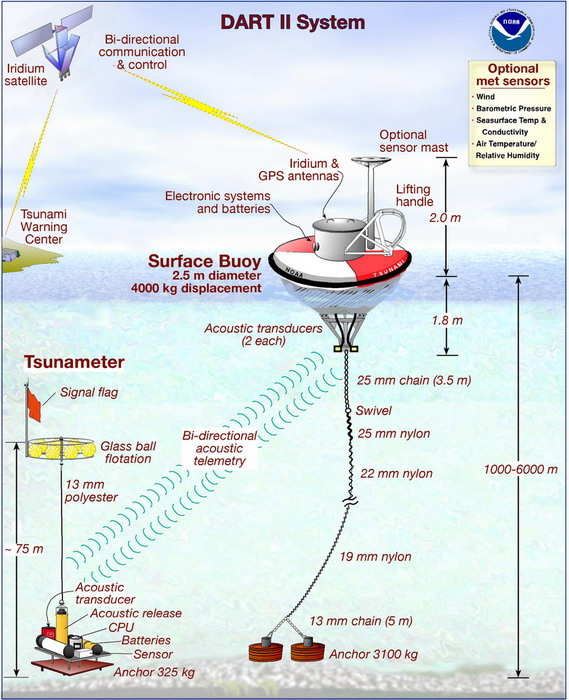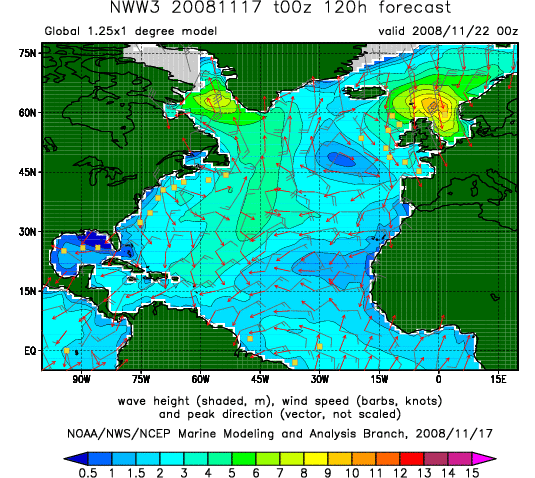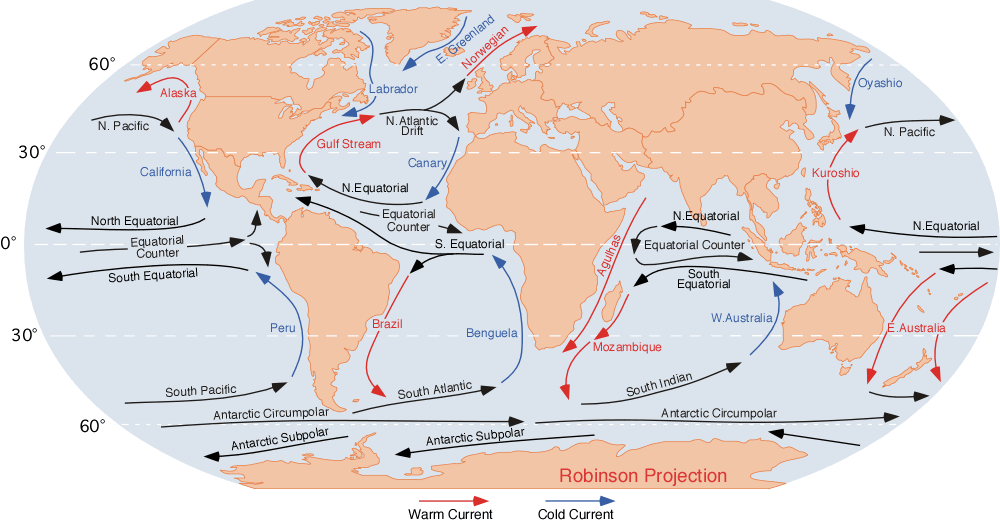|
SMART Cables
A SMART cable, or Science Monitoring And Reliable Telecommunications (SMART) cable, is a trans-ocean submarine communications cable that includes scientific instrumentation at multiple points along the cable for measuring environmental variables like temperature, pressure, or seismic acceleration. The cable itself provides the necessary power and communications for accessing and operating the instrumentation from shore. Information from the sensors is used for scientific and engineering studies, such as observing changes to climate or ocean circulation, or for monitoring for hazards like tsunamis, earthquakes or undersea land slides. Such hazards are threats not only to human life and property, but also to the communications cables themselves. SMART cables deployed along the ocean floor provide environmental information supporting sustainable development of coastal and offshore infrastructure. Their geophysical sensors contribute to tsunami and earthquake early warning systems. C ... [...More Info...] [...Related Items...] OR: [Wikipedia] [Google] [Baidu] |
Submarine Communications Cable
A submarine communications cable is a cable laid on the seabed between land-based stations to carry telecommunication signals across stretches of ocean and sea. The first submarine communications cables were laid beginning in the 1850s and carried telegraphy traffic, establishing the first instant telecommunications links between continents, such as the first transatlantic telegraph cable which became operational on 16 August 1858. Submarine cables first connected all the world's continents (except Antarctica) when Java was connected to Darwin, Northern Territory, Australia, in 1871 in anticipation of the completion of the Australian Overland Telegraph Line in 1872 connecting to Adelaide, South Australia and thence to the rest of Australia. Subsequent generations of cables carried telephone traffic, then data transmission, data communications traffic. These early cables used copper wires in their cores, but modern cables use optical fiber technology to carry digital data, whic ... [...More Info...] [...Related Items...] OR: [Wikipedia] [Google] [Baidu] |
United Kingdom
The United Kingdom of Great Britain and Northern Ireland, commonly known as the United Kingdom (UK) or Britain, is a country in Northwestern Europe, off the coast of European mainland, the continental mainland. It comprises England, Scotland, Wales and Northern Ireland. The UK includes the island of Great Britain, the north-eastern part of the island of Ireland, and most of List of islands of the United Kingdom, the smaller islands within the British Isles, covering . Northern Ireland shares Republic of Ireland–United Kingdom border, a land border with the Republic of Ireland; otherwise, the UK is surrounded by the Atlantic Ocean, the North Sea, the English Channel, the Celtic Sea and the Irish Sea. It maintains sovereignty over the British Overseas Territories, which are located across various oceans and seas globally. The UK had an estimated population of over 68.2 million people in 2023. The capital and largest city of both England and the UK is London. The cities o ... [...More Info...] [...Related Items...] OR: [Wikipedia] [Google] [Baidu] |
NEPTUNE
Neptune is the eighth and farthest known planet from the Sun. It is the List of Solar System objects by size, fourth-largest planet in the Solar System by diameter, the third-most-massive planet, and the densest giant planet. It is 17 times the mass of Earth. Compared to Uranus, its neighbouring ice giant, Neptune is slightly smaller, but more massive and denser. Being composed primarily of gases and liquids, it has no well-defined solid surface. Neptune orbits the Sun once every 164.8 julian year (astronomy), years at an orbital distance of . It is named after Neptune (mythology), the Roman god of the sea and has the astronomical symbol representing Trident of Poseidon, Neptune's trident. Neptune is not visible to the unaided eye and is the only planet in the Solar System that was not initially observed by direct empirical observation. Rather, unexpected changes in the orbit of Uranus led Alexis Bouvard to hypothesise that its orbit was subject to gravitational Pe ... [...More Info...] [...Related Items...] OR: [Wikipedia] [Google] [Baidu] |
Deep-ocean Assessment And Reporting Of Tsunamis
Deep-ocean Assessment and Reporting of Tsunamis (DART) is a component of an enhanced tsunami warning system. By logging changes in seafloor temperature and pressure, and transmitting the data via a surface buoy to a ground station by satellite, DART enables instant, accurate tsunami forecasts. In Standard Mode, the system logs the data at 15-minute intervals, and in Event Mode, every 15 seconds. A 2-way communication system allows the ground station to switch DART into Event Mode whenever detailed reports are needed. Stations Each DART station consists of a surface buoy and a seafloor bottom pressure recording (BPR) package that detects water pressure changes caused by tsunamis. The surface buoy receives transmitted information from the BPR via an acoustic link and then transmits data to a satellite, which retransmits the data to ground stations for immediate dissemination to NOAA's Tsunami Warning Centers, NOAA's National Data Buoy Center, and NOAA's Pacific Marine Environm ... [...More Info...] [...Related Items...] OR: [Wikipedia] [Google] [Baidu] |
The Conversation (website)
''The Conversation'' is a network of nonprofit media outlets publishing news stories and research reports online, authored by academics with professional journalist editors to produce accessible research-informed outputs. Articles are written by academics and researchers under a Creative Commons license, allowing reuse without modification. Copyright terms for images are generally listed in the image caption and attribution. Its model has been described as explanatory journalism. Except in "exceptional circumstances", it only publishes articles by "academics employed by, or otherwise formally connected to, accredited institutions, including universities and accredited research bodies". The website was launched in Australia in March 2011. The network has since expanded globally with a variety of local editions originating from around the world. In September 2019, ''The Conversation'' reported a monthly online audience of 10.7 million users, and a combined reach o ... [...More Info...] [...Related Items...] OR: [Wikipedia] [Google] [Baidu] |
Wind Wave Model
In fluid dynamics, wind wave modeling describes the effort to depict the sea state and predict the evolution of the energy of wind waves using numerical techniques. These simulations consider atmospheric wind forcing, nonlinear wave interactions, and frictional dissipation, and they output statistics describing wave heights, periods, and propagation directions for regional seas or global oceans. Such wave hindcasts and wave forecasts are extremely important for commercial interests on the high seas. For example, the shipping industry requires guidance for operational planning and tactical seakeeping purposes. For the specific case of predicting wind wave statistics on the ocean, the term ocean surface wave model is used. Other applications, in particular coastal engineering, have led to the developments of wind wave models specifically designed for coastal applications. Historical overview Early forecasts of the sea state were created manually based upon empirical rela ... [...More Info...] [...Related Items...] OR: [Wikipedia] [Google] [Baidu] |
Tide
Tides are the rise and fall of sea levels caused by the combined effects of the gravitational forces exerted by the Moon (and to a much lesser extent, the Sun) and are also caused by the Earth and Moon orbiting one another. Tide tables can be used for any given locale to find the predicted times and amplitude (or " tidal range"). The predictions are influenced by many factors including the alignment of the Sun and Moon, the phase and amplitude of the tide (pattern of tides in the deep ocean), the amphidromic systems of the oceans, and the shape of the coastline and near-shore bathymetry (see '' Timing''). They are however only predictions, the actual time and height of the tide is affected by wind and atmospheric pressure. Many shorelines experience semi-diurnal tides—two nearly equal high and low tides each day. Other locations have a diurnal tide—one high and low tide each day. A "mixed tide"—two uneven magnitude tides a day—is a third regular category. ... [...More Info...] [...Related Items...] OR: [Wikipedia] [Google] [Baidu] |
Sea Level Rise
The sea level has been rising from the end of the last ice age, which was around 20,000 years ago. Between 1901 and 2018, the average sea level rose by , with an increase of per year since the 1970s. This was faster than the sea level had ever risen over at least the past 3,000 years. The rate accelerated to /yr for the decade 2013–2022. Climate change due to human activities is the main cause. Between 1993 and 2018, melting ice sheets and glaciers accounted for 44% of sea level rise, with another 42% resulting from thermal expansion of water. Sea level rise lags behind changes in the Earth's temperature by decades, and sea level rise will therefore continue to accelerate between now and 2050 in response to warming that has already happened. What happens after that depends on future human greenhouse gas emissions. If there are very deep cuts in emissions, sea level rise would slow between 2050 and 2100. The reported factors of increase in flood hazard potential are often e ... [...More Info...] [...Related Items...] OR: [Wikipedia] [Google] [Baidu] |
Ocean Current
An ocean current is a continuous, directed movement of seawater generated by a number of forces acting upon the water, including wind, the Coriolis effect, breaking waves, cabbeling, and temperature and salinity differences. Depth contours, shoreline configurations, and interactions with other currents influence a current's direction and strength. Ocean currents move both horizontally, on scales that can span entire oceans, as well as vertically, with vertical currents (upwelling and downwelling) playing an important role in the movement of nutrients and gases, such as carbon dioxide, between the surface and the deep ocean. Ocean currents flow for great distances and together they create the global conveyor belt, which plays a dominant role in determining the climate of many of Earth's regions. More specifically, ocean currents influence the temperature of the regions through which they travel. For example, warm currents traveling along more temperate coasts increase the temper ... [...More Info...] [...Related Items...] OR: [Wikipedia] [Google] [Baidu] |
Climate Change
Present-day climate change includes both global warming—the ongoing increase in Global surface temperature, global average temperature—and its wider effects on Earth's climate system. Climate variability and change, Climate change in a broader sense also includes previous long-term changes to Earth's climate. The current rise in global temperatures is Scientific consensus on climate change, driven by human activities, especially fossil fuel burning since the Industrial Revolution. Fossil fuel use, Deforestation and climate change, deforestation, and some Greenhouse gas emissions from agriculture, agricultural and Environmental impact of concrete, industrial practices release greenhouse gases. These gases greenhouse effect, absorb some of the heat that the Earth Thermal radiation, radiates after it warms from sunlight, warming the lower atmosphere. Carbon dioxide, the primary gas driving global warming, Carbon dioxide in Earth's atmosphere, has increased in concentratio ... [...More Info...] [...Related Items...] OR: [Wikipedia] [Google] [Baidu] |
Deep Ocean Water
Deep ocean water (DOW) is the name for cold, salty water found in the deep sea, starting at below the surface of Earth's oceans. Ocean water differs in temperature and salinity. Warm surface water is generally saltier than the cooler deep or polar waters; in polar regions, the upper layers of ocean water are cold and fresh. Deep ocean water makes up about 90% of the volume of the oceans. Deep ocean water has a very uniform temperature, around , and a salinity of about 3.5% or, as oceanographers state, 35‰ (parts per thousand). In specialized locations, such as the Natural Energy Laboratory of Hawaii, ocean water is pumped to the surface from approximately deep for applications in research, commercial and pre-commercial activities. DOW is typically used to describe ocean water at sufficient to provide a measurable difference in water temperature. When deep ocean water is brought to the surface, it can be used for a variety of things. Its most useful property is its tempera ... [...More Info...] [...Related Items...] OR: [Wikipedia] [Google] [Baidu] |
Real-time Communication
Real-time communication (RTC) is a category of software protocols and communication hardware media that gives real-time guarantees, which is necessary to support real-time guarantees of real-time computing. Real-time communication Protocols (computing), protocols are dependent not only on the Data integrity, validity and integrity of data transferred but also the timeliness of the transfer. Real-time communication systems are generally understood as one of two types: ''Hard Real-Time (HRT)'' and ''Soft Real-Time (SRT)''. The difference between a hard and soft real-time communication system is the consequences of incorrect operation. Safety-critical systems capable of causing catastrophic consequences upon a fault, such as Fly-by-wire, aircraft fly-by-wire systems, are designated as hard real-time, whereas non-critical but ideally real-time systems, such as hotel reservation systems, are designated as soft real-time. The designation of a real-time communication system as hard or sof ... [...More Info...] [...Related Items...] OR: [Wikipedia] [Google] [Baidu] |






